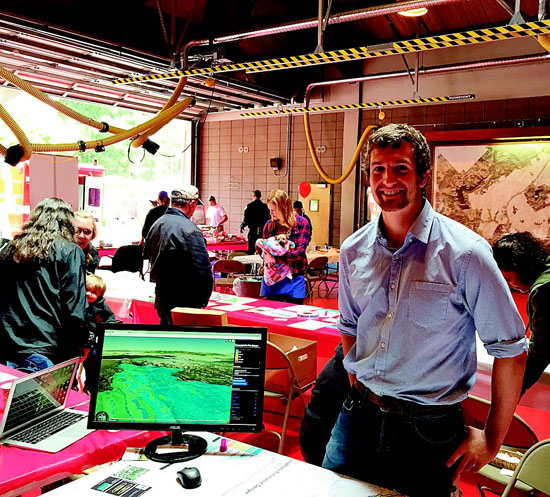 |
|
|
Founder and FireSphere developer Scott Farley promotes his crowd-sourced app during a May open house at the Orinda fire station on Orinda Way. Photo Cathy Dausman
|
|
|
|
|
|
Scott Farley came to the East Bay seeking water; as a student at UC Berkeley he joined the swim team. But it was another element - fire - that caught his attention six years ago, and helps explain the mobile app and website he has developed to aid Lamorindans in recording and understanding the fire risk they face daily living on the wild land urban interface.
 In 2009 Farley, who is originally from Southern California, watched in fascination for weeks as fire crews battled the Station Fire, the largest and deadliest of California wildfires that year. An interest in cartography and geography and the need to develop an undergrad thesis prompted Farley to improve the standards of the National Fire Danger Rating System.
In 2009 Farley, who is originally from Southern California, watched in fascination for weeks as fire crews battled the Station Fire, the largest and deadliest of California wildfires that year. An interest in cartography and geography and the need to develop an undergrad thesis prompted Farley to improve the standards of the National Fire Danger Rating System.
 The U.S. Department of Agriculture explains NFDRS as "a system that allows fire managers to estimate today's or tomorrow's fire danger for a given area," taking into consideration "fuels, weather, topography and risks."
The U.S. Department of Agriculture explains NFDRS as "a system that allows fire managers to estimate today's or tomorrow's fire danger for a given area," taking into consideration "fuels, weather, topography and risks."
 The color-coded fire danger scale runs from "low" to "extreme." NFDRS maps are built from satellite imagery in 30-by-30 meter boxes (approximately one half mile across); Farley's app increases the resolution to one square meter by applying 750,000 points within that box.
The color-coded fire danger scale runs from "low" to "extreme." NFDRS maps are built from satellite imagery in 30-by-30 meter boxes (approximately one half mile across); Farley's app increases the resolution to one square meter by applying 750,000 points within that box.
 Like NFDRS, FireSphere (www.firesphere.org ) grades fire danger based on available fuel sources (grass, trees, type, etc.) and paints a computer-generated color picture of relative wild land fire danger. But satellite imagery may confuse non-burnable concrete with burnable grassland topography. FireSphere makes the distinction, because each user photographs the area and compares it with cached pictures of fire fuels before it is submitted. The information is then geolocated, compiled, and becomes part of the interactive FireSphere website, which produces daily updates on current and predicted local wildfire conditions.
Like NFDRS, FireSphere (www.firesphere.org ) grades fire danger based on available fuel sources (grass, trees, type, etc.) and paints a computer-generated color picture of relative wild land fire danger. But satellite imagery may confuse non-burnable concrete with burnable grassland topography. FireSphere makes the distinction, because each user photographs the area and compares it with cached pictures of fire fuels before it is submitted. The information is then geolocated, compiled, and becomes part of the interactive FireSphere website, which produces daily updates on current and predicted local wildfire conditions.
 As a free, crowdsourced mobile app, FireSphere relies on users to submit data. The test market is within the confines of the Moraga-Orinda Fire District, but Farley hopes to expand his project to include the city of Lafayette. The more users FireSphere has, the clearer the local fire danger "picture" becomes.
As a free, crowdsourced mobile app, FireSphere relies on users to submit data. The test market is within the confines of the Moraga-Orinda Fire District, but Farley hopes to expand his project to include the city of Lafayette. The more users FireSphere has, the clearer the local fire danger "picture" becomes.
 Farley has begun speaking to local organizations to raise public awareness about FireSphere. He spoke to the Mt. Diablo Silverado Boy Scout Council in May and was scheduled to attend the Lamorinda CERT training session in Orinda July 13.
Farley has begun speaking to local organizations to raise public awareness about FireSphere. He spoke to the Mt. Diablo Silverado Boy Scout Council in May and was scheduled to attend the Lamorinda CERT training session in Orinda July 13.

|
